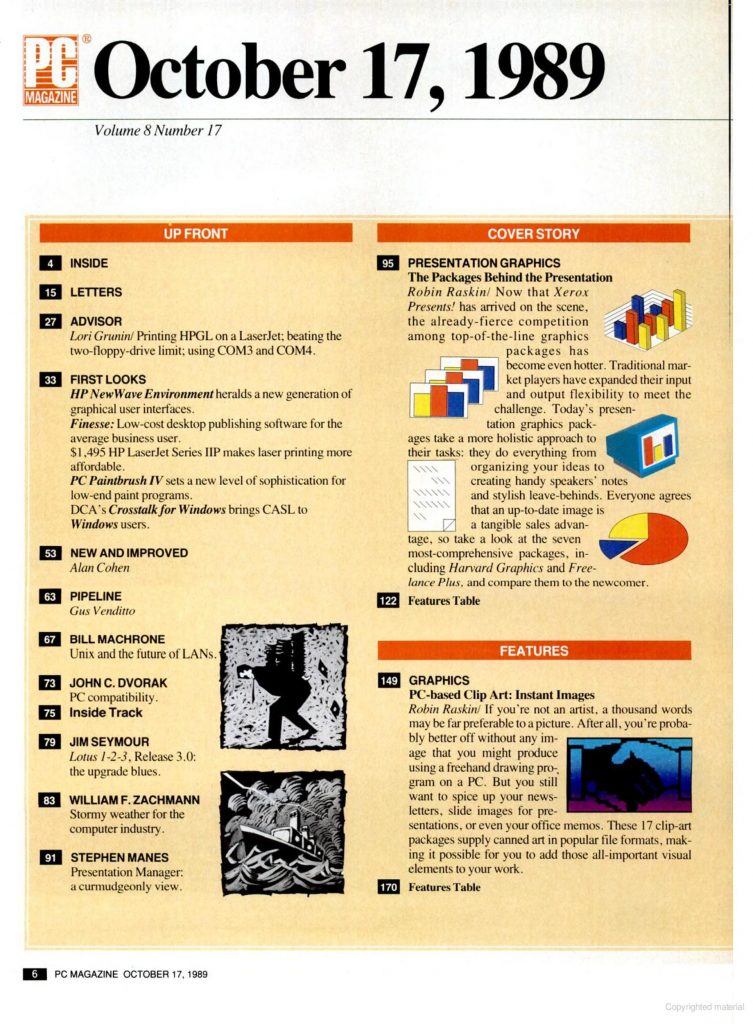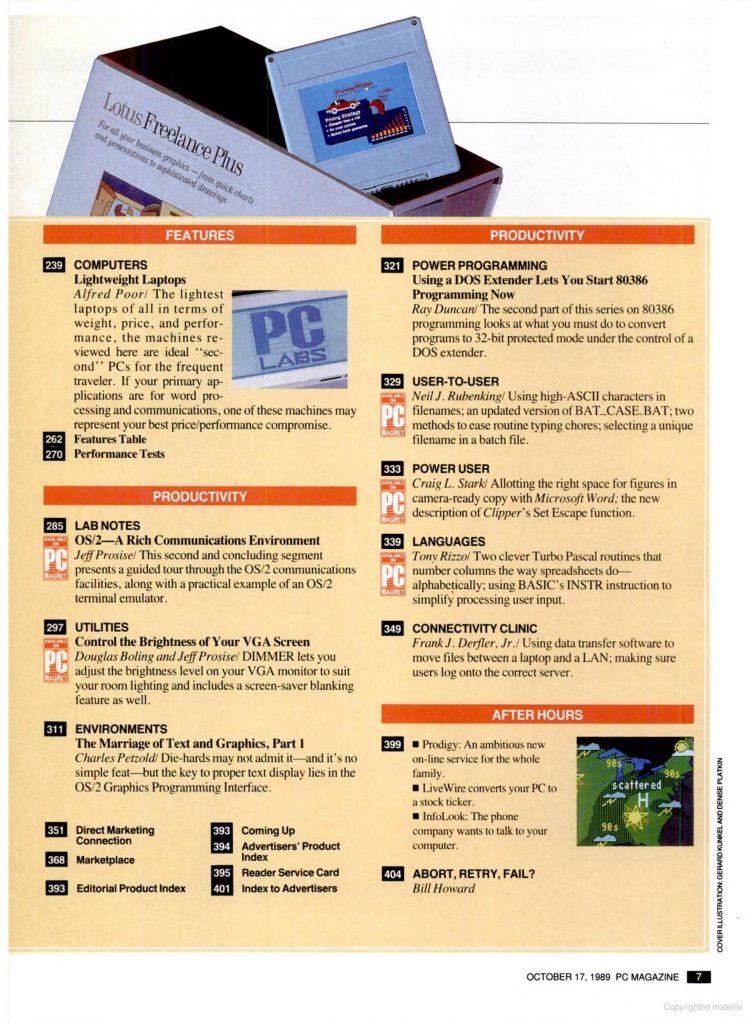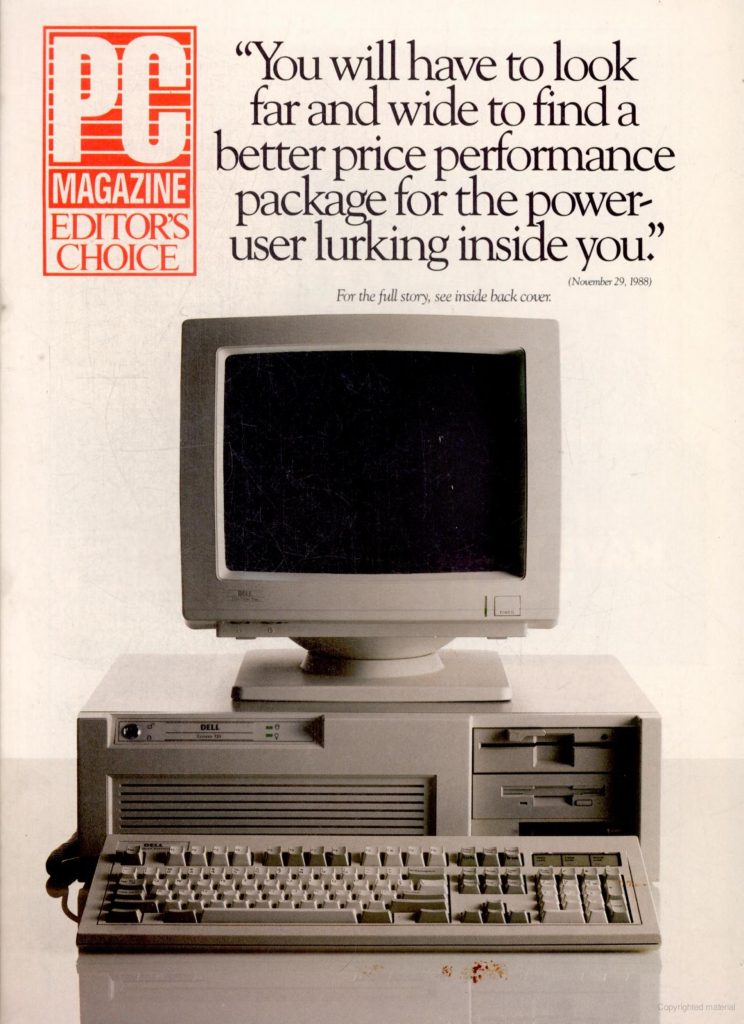Source: PC World – March 1988
PC World was one of the most successful PC magazines (PC meaning x86 compatible). It had a long life before the Internet killed it. The March 1988 issue includes:
Review
- Excel – Should You Switch? – Excel makes its debut, ultimately spelling the end for products like Lotus 1-2-3 and VisiCalc.
- Thoroughly Modern Modems – Hayes releases new V-Series modems which include internal and external 9600bps and 2400bps models. They sure were expensive though with prices ranging from $849 to $1299. Prices would drop like a rock over the next few years.
- Smartcom Wises Up – Smartcom III, a communications/terminal program, was released to coincide with Hayes’ new modems. Crosstalk Mk.4 still had more features.
- Making the E-Mail Choice – E-mail in the 1980s was a hodge-podge of various services. Typically they charged by the e-mail or by the length. Various services all had their own limitations and pricing scheme.
- Worksheets Without 1-2-3 – A look at worksheet compilers that create standalone applications from your worksheets. The two products examined here are The Baler and @Liberty.

- The Hardware Shelf – A look at the Amstrad PC1640 (XT-compatible 8086 from $899 to $1899 depending on the floppy, hard drive, and graphics options you want), the Wang PC 380 (80386 based system starting at $6495), the Toshiba T1000 (an 80C88 based laptop with 512K and 3.5″ disk drive for $1199), the Polaroid PallettePlus (a “film recorder” that converts CGA and EGA graphics to film slides for $3000), and the FastTrap trackball.
- The Software Shelf – Reviews of some of the latest software, including Microsoft Works, PageMaker Portfolio: Designs for Newsletters, OfficeWriter Express, Vu/Text, and MemoryMate.
Feature
- 1988 World Class PC Contest – A contest in which you get to vote for your favorite hardware and software for a chance to win prices worth over $40,000.
- Putting E-Mail to Work – A look at various e-mail services as an alternative to more traditional and expensive methods of sending documents (FedEx for example).
- A License to Clone – An article about the supposed deluge of PS/2 clones to come. This never really happened and Micro Channel Architecture never really took off except for the relatively brief years that IBM used it.
How To
- E-Mail to Anywhere – A tutorial on how to send e-mail between various networks.
Departments
- David Bunnell – A look at what was a somewhat novel idea at the time, an external hard drive system. Today you have a USB device the size of a key (or smaller) that holds hundreds of gigabytes (or more) for a few 10s of dollars. Then you had an external 2 pound brick that held 40MB for $350
- Letters – Readers write in about computer journalism ethics, benchmarking, DacEasy Accounting 2.00, the Remedy Removable Winchester drive, and more.
- Richard Landry – OS/2’s high cost and incompatibility is leading to a split in the market but software vendors are working to make data compatible between applications on OS/2 and other operating systems.
- Stewart Alsop – A prediction that the hottest new persona computer for software development in January 1990 will be from Sun Microsystems.
- On IBM – IBM’s strategy of using SAA (Systems Application Architecture) to allow their various non-compatible mainframes, minicomputers, and PCs to talk to each other.
- Top of the News – Micro Channel clones come closer to market; as VRAM prices drop, manufacturers of graphics cards start using faster VRAM instead of DRAM; HP introduces NewWave, a development tool for Windows 2.0; and more.
- Industry Outlook – A look at Hayes’ strategy of high end modems and ISDN support; 376,400 laptops sold in 1987 with a projected 621,000 by 1989; memory prices hold steady at $0.65 to $0.75 per kilobyte; four floppy disk formats still common (low and high density 3.5″ and 5.25″); and more.
- Product Outlook – A look at upcoming products including Info-XL (information management software), Canon Bubble-Jet BJ-130 printer, ImageCard (PostScript-compatible printer controller), Fill & File (forms generator), TransFormer 2 (PS/2 expansion bus), Pixie (presentation graphics software), and the GS/1-IP Gateway Server (network server for connecting separate LANs).
- Briefly Noted – A brief look at new products including DataPerfect 2.0 (database management), Diconix 300W (ink jet printer), NexView, The Wheel, CM-1430 (hire-res color monitor), and Paradise VGA Professional and VGA Plus cards.
- Update – Recent software and hardware updates including Word for Word (conversion utility), Clipper Summer ’87 (dBASE III Plus compiler), Quicksilver Diamond Release (another dBASE III Plus compiler), Zenith Z-183 laptop (added hard drive), and more.
- Consumer Watch – What to look for in computer benchmarking.
- The Help Screen – How to capture printer output to a disk file, port Apple II files to the PC, disable the Print Screen key and more.
- Tech Notes – The upgrade dilemma… 286 or 386? OS/2, DOS or Windows?
- Sourcebooks – Book reviews including Big Blue: IBM’s Use and Abuse of Power, High-Tech Society: The Story of the Information Technology Revolution, Expert System Technology: Development and Application, The Gem Operating System Handbook, and more.
- Another Angle – On the selfishness of BBS users.

…and more!












